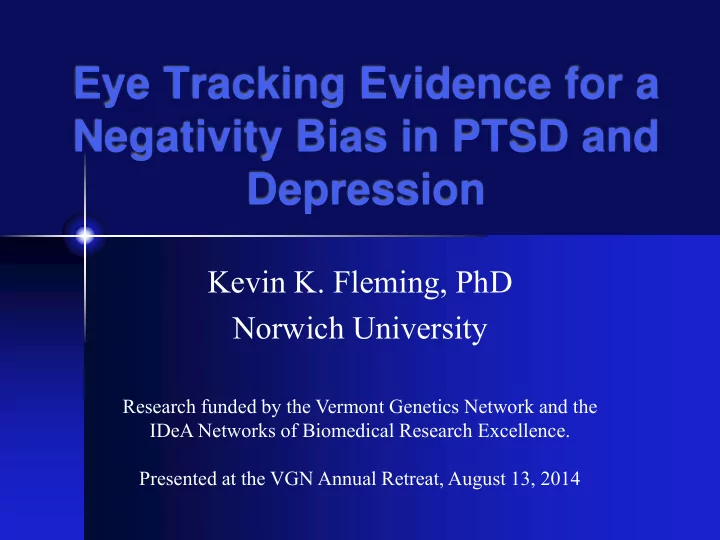

Eye Tracking Evidence for a Negativity Bias in PTSD and Depression Kevin K. Fleming, PhD Norwich University Research funded by the Vermont Genetics Network and the IDeA Networks of Biomedical Research Excellence. Presented at the VGN Annual Retreat, August 13, 2014
Research reported in this presentation was supported by an Institutional Development Award (IDeA) from the National Institute of General Medical Sciences of the National Institutes of Health under grant number P20GM103449. Its contents are solely the responsibility of the authors and do not necessarily represent the official views of NIGMS or NIH.
Historical Background -- Post-Traumatic Stress Disorder (PTSD) and Depression are both serious mental illnesses that require early diagnosis and intervention. -- High co-morbidity rates between PTSD and Depression. -- Combat soldiers are at high risk. -- Risk of suicide is highest when serotonin levels are low. -- Drug treatments are designed to elevate serotonin.
Historical Background -- What can Cognitive Neuroscience contribute to the understanding and treatment of PTSD and Depression? -- Aaron Beck, University of Pennsylvania, BDI. -- Edna Foa, University of Pennsylvania, PSS-17. -- Michael Posner, University of Oregon. -- Attentional Models of PTSD and Depression.
Historical Background -- What can Eye Tracking evidence reveal? -- Eyes move 5-10 times per second. -- Eye fixations last 100-200 milliseconds. -- Eye movements (saccades) take 50-70 milliseconds. -- Eye Blinks last about 100 milliseconds. -- Eye movements are pre-planned, ballistic movements that are programmed in the superior colliculus.
Primary Visual Pathway:
Secondary Visual Pathway:
Historical Background -- What can Eye Tracking evidence reveal about Attention? -- Dual Process models: - Automatic Processes - Controlled Processes -- Eye movements provide a window into the brain’s ability to focus and shift attention, to gather information for more detailed processing, and to shape the content of consciousness and memory.
Historical Background -- What is Negativity Bias and How can it be Measured? -- People tend to look at negative valenced information. -- People with PTSD look at negative information more. -- Soldiers with PTSD look at negative information even more. -- Eye Tracking evidence shows distinct Negativity Bias. - More eye fixations - Longer eye fixations - Larger pupil dilation
Our Methods -- Show split screen slides for 10 seconds each. -- Record Eye Movements using SR EyeLink 1000. -- Sample Images:
Our Methods Image 1.
Our Methods Image 2.
Our Methods Image 3.
Our Methods Image 4.
Our Methods Image 5.
Our Methods Image 6.
Our Results Fixation Map.
Our Results Saccade Map.
Our Results Composite Map.
Our Results Movie Clip.
Our Results Movie Clip.
Our Results Movie Clip.
Our Results Movie Clip.
Our Results Journal of Anxiety Disorders paper published in 2010.
Our Results Tables from 2010 Paper in Journal of Anxiety Disorders.* *Full article available online through ResearchGate.
Replications and Meta Analysis Clinical Psychology Review, 2012, Armstrong and Olatunji.
Replications and Meta Analysis Clinical Psychology Review, 2012, Armstrong and Olatunji.
Replications and Meta Analysis Clinical Psychology Review, 2012, Armstrong and Olatunji.
Conclusions -- Negativity Bias in PTSD is reliable and robust. -- Evidence is found in all measures of eye movements: - Number of Fixations - Duration of First Fixations - Gaze Duration - Pupil Dilation -- Evidence is found in Split Screen tasks, but others: - Faces - Images - Words
Further Research -- Developing a Comprehensive Model of PTSD in Soldiers. -- Optimal Psychological Health. -- Predictors of Negativity Bias - Genetic Predisposition (Low Serotonin) - Childhood Stress or Trauma - Military Training - Combat Exposure - Clinical PTSD Diagnosis --Schematic
Thank You.
Recommend
More recommend